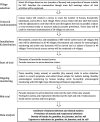Evaluating the impact of screening plus eave tubes on malaria transmission compared to current best practice in central Côte d'Ivoire: a two armed cluster randomized controlled trial
- PMID: 30021543
- PMCID: PMC6052618
- DOI: 10.1186/s12889-018-5746-5
Evaluating the impact of screening plus eave tubes on malaria transmission compared to current best practice in central Côte d'Ivoire: a two armed cluster randomized controlled trial
Abstract
Background: Access to long-lasting insecticidal nets (LLINs) has increased and malaria has decreased globally, but malaria transmission remains high in parts of sub-Saharan Africa and insecticide resistance threatens current progress. Eave tubes are a new tool for the targeted delivery of insecticides against mosquitoes attempting to enter houses. The primary objective of this trial is to test whether screening plus eave tubes (SET) provides protection against malaria, on top of universal coverage with LLINs in an area of intense pyrethroid resistance. The trial will also assess acceptability and cost-effectiveness of the intervention.
Methods/design: A two-armed, cluster randomized controlled trial will be conducted to evaluate the effect of SET on clinical malaria incidence in children living in central Côte d'Ivoire. Forty villages will be selected based on population size and the proportion of houses suitable for modification with SET. Using restricted randomization, half the villages will be assigned to the treatment arm (SET + LLINs) and the remainder will be assigned to the control arm (LLINs only). In both arms, LLINs will be distributed and in the treatment arm, householders will be offered SET. Fifty children aged six months to eight years old will be enrolled from randomly selected households in each of the 40 villages. Cohorts will be cleared of malaria parasites at the start of the study and one year after recruitment, and will be monitored for clinical malaria case incidence by active case detection over two years. Mosquito densities will be assessed using CDC light traps and human landing catches and a subset of Anopheles mosquitoes will be examined for parity status and tested for sporozoite infection. Acceptability of SET will be monitored using surveys and focus groups. Cost-effectiveness analysis will measure the incremental cost per case averted and per disability-adjusted life year (DALY) averted of adding SET to LLINs. Economic and financial costs will be estimated from societal and provider perspective using standard economic evaluation methods.
Discussion: This study will be the first evaluation of the epidemiological impact of SET. Trial findings will show whether SET is a viable, cost-effective technology for malaria control in Côte d'Ivoire and possibly elsewhere.
Trial registration: ISRCTN18145556 , registered on 01 February 2017 - retrospectively registered.
Keywords: Clinical malaria; Cost-effectiveness; Eave tubes; Economic evaluation; House screening; Housing; LLINs; Malaria control; SET; Screening plus eave tubes.
Conflict of interest statement
Ethics approval and consent to participate
This study is to be conducted in accordance with the principles set forth in the ICH Harmonized Tripartite Guideline for Good Clinical Practice and the Declaration of Helsinki in its current version.
The Côte d’Ivoire Ministry of Health ethics committee approved this study on 4 August 2015 (ref: 039/MSLS/CNER-dkn). It is also approved by the Pennsylvania State University’s Human Research Protection Program under the Office for Research Protections on 15 March 2016 (social science and SET installation protocol, ref.: STUDY00003899) and 27 Oct. 2016 (epidemiological and entomological monitoring protocol, ref.: STUDY00004815) and the London School of Hygiene and Tropical Medicine on 11 May 2017 (ref: 11223). Written consent is obtained from all participants prior to their enrollment in the study. Approval for any important protocol modifications will be sought from these three ethics committees.
Consent for publication
Not applicable.
Competing interests
The authors declare that they have no competing interests.
Publisher’s Note
Springer Nature remains neutral with regard to jurisdictional claims in published maps and institutional affiliations.
Figures
References
-
- World Health Organization. World Malaria Report 2016. 2016. Available from: http://apps.who.int/iris/bitstream/10665/252038/1/9789241511711-eng.pdf?.... Accessed 9 Jan 2017.
-
- World Health Organization. Global technical strategy for malaria 2016–2030. 2015. http://apps.who.int/iris/bitstream/handle/10665/176712/9789241564991_eng.... Accessed 1 June 2017.
Publication types
MeSH terms
Substances
Associated data
Grants and funding
LinkOut - more resources
Full Text Sources
Other Literature Sources
Medical




